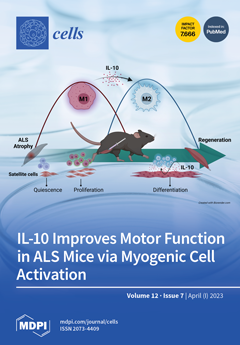Disuse atrophy of skeletal muscle is associated with a severe imbalance in cellular Ca
2+ homeostasis and marked increase in nuclear apoptosis. Nuclear Ca
2+ is involved in the regulation of cellular Ca
2+ homeostasis. However, it remains unclear whether nuclear Ca
2+ levels change under skeletal muscle disuse conditions, and whether changes in nuclear Ca
2+ levels are associated with nuclear apoptosis. In this study, changes in Ca
2+ levels, Ca
2+ transporters, and regulatory factors in the nucleus of hindlimb unloaded rat soleus muscle were examined to investigate the effects of disuse on nuclear Ca
2+ homeostasis and apoptosis. Results showed that, after hindlimb unloading, the nuclear envelope Ca
2+ levels ([Ca
2+]
NE) and nucleocytoplasmic Ca
2+ levels ([Ca
2+]
NC) increased by 78% (
p < 0.01) and 106% (
p < 0.01), respectively. The levels of Ca
2+-ATPase type 2 (Ca
2+-ATPase2), Ryanodine receptor 1 (RyR1), Inositol 1,4,5-tetrakisphosphate receptor 1 (IP
3R1), Cyclic ADP ribose hydrolase (CD38) and Inositol 1,4,5-tetrakisphosphate (IP
3) increased by 470% (
p < 0.001), 94% (
p < 0.05), 170% (
p < 0.001), 640% (
p < 0.001) and 12% (
p < 0.05), respectively, and the levels of Na
+/Ca
2+ exchanger 3 (NCX3), Ca
2+/calmodulin dependent protein kinase II (CaMK II) and Protein kinase A (PKA) decreased by 54% (
p < 0.001), 33% (
p < 0.05) and 5% (
p > 0.05), respectively. In addition, DNase X is mainly localized in the myonucleus and its activity is elevated after hindlimb unloading. Overall, our results suggest that enhanced Ca
2+ uptake from cytoplasm is involved in the increase in [Ca
2+]
NE after hindlimb unloading. Moreover, the increase in [Ca
2+]
NC is attributed to increased Ca
2+ release into nucleocytoplasm and weakened Ca
2+ uptake from nucleocytoplasm. DNase X is activated due to elevated [Ca
2+]
NC, leading to DNA fragmentation in myonucleus, ultimately initiating myonuclear apoptosis. Nucleocytoplasmic Ca
2+ overload may contribute to the increased incidence of myonuclear apoptosis in disused skeletal muscle.
Full article






